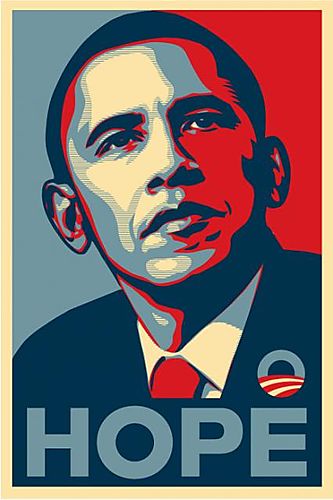The current kerfuffle over the iconic description of Obama puts us in mind of last month’s piece by our Sameer Pandya, who asked what the limits were to copyright in the remix era.
For those out of the loop, artist Shepard Fairey used a photo from then-Associated Press photographer Mannie Garcia as the basis for his now iconic image of Barack Obama. As Los Angeles Timesblogger Sherry Stern put it in a nice turn of phrase, “(Fairey’s) ‘Hope’ poster of candidate Obama turned from guerrilla art to refrigerator magnet to a spot on the wall of the National Portrait Gallery.” (That’s it to the lower left, used totally without permission.)
It also attracted the notice of the AP, which wants to be credited as the source of the image and get some moolah that all this to-ing and fro-ing presumably has generated. Although his career received a stimulus package-size boost, Fairey apparently didn’t really make a ton of money from the picture, since most of its users just grabbed his shot and the authorized sales saw the money go to nonprofits.

Lawyers for the AP sent Fairey a letter; his lawyers fired back with their missive citing “fair use.” We’ll let the lawyers and their postmen continue that battle (and after noting that Mr. Fairey has his own finely attuned sense of umbrage when it’s his works being kiped.)
Susie Fitzhugh, commenting on the NPR story about the dispute, points to the case of Rogers v. Koons. (We weren’t going to credit Fitzhugh with the inspiration for this paragraph, but thought better of stealing her idea …) Anyway, the painter — in this case Jeffrey Koons, lost a copyright battle with photographer Art Rogers over a popular black-and-white puppy picture Rogers took. Point AP. But in the federal appeals court judgment, this tidbit appears: “‘Puppies’ is the product of plaintiff’s artistic creation. Rogers’ inventive efforts in posing the group for the photograph, taking the picture, and printing ‘Puppies’ suffices to meet the original work of art criteria.” One wonders if Garcia’s efforts meet the same standard. Point Fairey.
But let’s return to Sameer’s piece, which spends a fair amount of time examining Creative Commons honcho Lawrence Lessig‘s prescriptions for remixing copyright law. “Copyright law regulates cultures in America,” Lessig is quoted. “Copyright law must be changed. Changed, not abolished.”
And as Sameer concludes:
“One can agree or disagree with Lessig’s prescription for dealing with copyright. But the core of his argument is a response to a wider, exciting cultural moment that asks us to consider, following this idea of remix, the work of art in the age of digital reproduction.”



